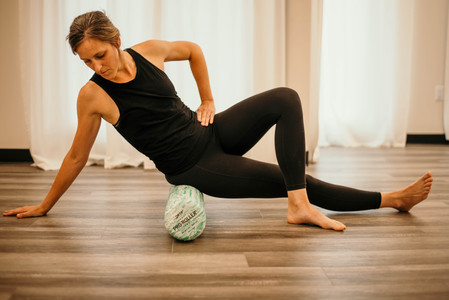Contributed by Becca Ellis, PT, DPT, PYT-c, ERYT-200s,
What is it & why should patients be doing it?
A yoga practice can offer a plethora of benefits for people wanting to improve both mental and physical health. In a study done in 2013 by Sinha, et al, a group of individuals were shown to have enhanced parasympathetic tone following 6 weeks of yogic breathing done for only 5-minutes per day. When yoga is instructed by a physical therapist, components are included to address a person’s impairments and functional limitations due to injury or chronic conditions.
Our medical yoga therapists at RTC have been trained under Ginger Garner, a physical therapist and founder of The Living Well Institute. The specific type of yoga learned in their training is called Medical Therapeutic Yoga and is an evidence-based practice that includes assessment protocols and therapeutic intervention using mind-body practices supported by scientific evidence. Sessions at RTC include breath work, meditation, and physical movement- all tailored to the patient’s needs based on a thorough evaluation. One-on-one and group instruction are offered at our center to help support the goals for each patient.
What conditions or issues would be ideal for yoga at The Studio @RTC?
Chronic pain
Myofascial pain and dysfunction
Postural pain and dysfunction
Lumbo-pelvic pain and instability
Post physical therapy wellness
What are the top 5 benefits of a therapeutic yoga practice?
Trunk/Core stability
Joint mobility
Soft-tissue extensibility
Body awareness
Central system regulation
Trunk Stability - Lumbo-pelvic stabilization is a key component of physio-based yoga instruction and it is one of the first concepts introduced. Improving trunk stability leads to improved functional movement patterns, increased safety, and enhanced body awareness during activities of daily living and during social or sporting activities, decreasing the chance of nagging overuse injuries of the hips and lower back.
Joint Mobility - Non-weight bearing and weight bearing postures are explored during yoga that encourage range of motion for all the joints in the body. Instruction led by a PT takes into consideration joint restrictions and can offer modifications to any yoga posture to ensure safety in movement. This also encourages joint fluidity into areas in need so that the joint range of motion can improve safely. Ultimately, proper joint range of motion can lead to improved function with less chance of soft tissue injury.
Soft Tissue Extensibility - Widespread body pain and tightness are the leading reasons people seek out treatments like PT, massage, acupuncture, etc. When an appropriate yoga practice is performed regularly, a person with soft tissue conditions, like myofascial dysfunction, can find pain relief that can have long lasting effects. During a session or class we take into consideration common areas of tissue tightness and address the myofascial lines of the body so the patient leaves a session with a sense of length and a feeling of freedom during movement.
Kinesthetic Awareness - Improving a person’s breath and body awareness can be a key factor in improving function and avoiding injury. During a session or class, our patients are asked to coordinate their breathing cycles with movement, and they are asked to move with control from one posture to the next while trying to avoid loss of balance. We integrate mindfulness into all our physio-based classes to support the mind-body connection. Increased kinesthetic awareness occurs with consistent efforts done over a long period of time, so a regular yoga practice is encouraged in order to see these gains. We encourage this consistency with our patients because our end goal is to translate this awareness into real life situations. Improving a person’s awareness during daily activities can ultimately decrease the chance of falling or other injuries occurring because of poor body mechanics.
Central System Regulation - Stress is known to be a factor for most patients who live with chronic pain syndromes, and learning ways to control stress is important in the health of the individual living with chronic pain. Breathing exercises and relaxation techniques can be a great way to stimulate the parasympathetic system, ultimately starting a cascade of calming effects like lowering blood pressure, regulating heart rhythms, and decreasing respiratory rate. A PT-based yoga practice always includes breath work that stimulates this effect so that our patients leave feeling better balanced, calmer, and more in control.
We would love to help introduce this wonderful mind-body practice to our community!
Please visit our website www.thestudiortc.com for easy online booking, or call our office at 757-578-2958 to set up an evaluation with one of our physical therapists to get started.
We offer private and group instruction as well as low cost monthly memberships to best support the needs of our clients. We believe everyone should have a chance to live well in their body, and we are here to help get our clients started and be the support they need along their path to wellness!
Article cited: Sinha A, et al. Assessment of the effects of Pranayama/Alternate Nostril Breathing on the Parasympathetic Nervous System in Young Adults. J Clin Diagn Res. 2013 May; 7(5): 821–823.











Kommentare